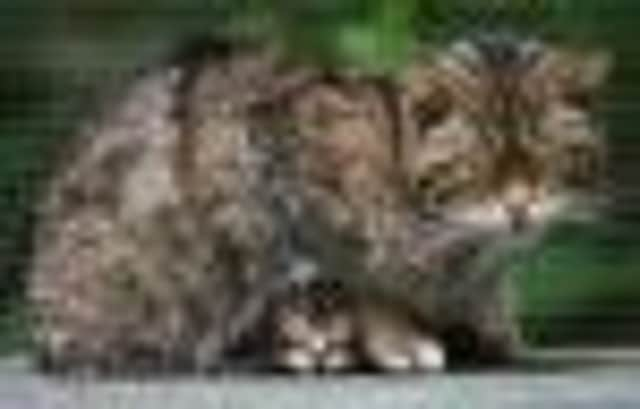Trap set to catch Scottish wildcats on camera


But now National Trust for Scotland (NTS) staff are being trained in documentary film techniques in a bid to capture exclusive footage of Scottish wildcats.
The project, which is also aimed at catching a host of other secretive creatures and animal behaviour, was part-inspired by Scots wildlife cameraman Gordon Buchanan’s work on hit documentary The Lost Land Of The Tiger.
Advertisement
Hide AdAdvertisement
Hide AdBuchanan tracked the Bengal tiger – the world’s largest big cat breed – high in the Himalayas, braving freezing temperatures and hiking for hours to set camera “traps” which produced the first images proving that the predators had survived in the remote kingdom of Bhutan, at a place and altitude where they were not thought to live.
The NTS hopes to generate similar footage of wildcats, dubbed the “Highland tiger”, through its film project.
Just over a dozen employees have been trained so far and remote camera traps like the ones used by Buchanan in Bhutan are being installed at various NTS sites, including Aberdeenshire properties where wildcats are still thought to survive.
Although they have yet to obtain pictures of the cats, the earliest edited film produced through the £120,000 project features the first ever footage of grey seals pupping at the NTS national nature reserve at St Abbs in Berwickshire.
Training is being led by John Aitchison who, like Buchanan, is a renowned filmmaker based in Scotland and has worked on the BBC series Frozen Planet.
He said: “It’s a great project. The NTS owns some of the best places in the country for natural history which are rich in wildlife and the staff are all very dedicated and motivated.
“It’s far easier to teach a natural historian how to film wildlife than it is to teach a filmmaker about natural history because filming wildlife is more about natural history than about filming. The cameras can seem complicated, but everyone has made great strides.”
Staff are still shooting and editing footage, which is due to be added to the Trust’s website as well as being shown on screens at various NTS properties from Easter. There are also plans to film “how we got the shot” segments of the kind which have become a popular part of wildlife documentaries.
Advertisement
Hide AdAdvertisement
Hide AdBuchanan offered NTS staff advice on how to get the most from the traps. He said: “It’s very exciting because they allow you to get shots which would be impossible to get by any other means.
“Your presence as a cameraman has quite an effect and some of these predators are quite wary, but with a trap the animals are entirely oblivious to the fact that they are being watched.
“The cameras are easy to put up, but you have to think carefully about where you put them. If they are pointing in the wrong direction you can miss all sorts of things.”
Ecologist Dr Shaila Rao, who is based at the NTS Mar Lodge in the Cairngorms National Park, has been getting up at 3am to film the renowned black grouse displays known as “lecking”, which start just before dawn as males strive to impress the females.
She said: “You have to get into the hide before they arrive so you don’t disturb them. It’s a great challenge and it’s fun while the birds are there, but it gets chilly when you have to wait for them to leave before you can go. John has been absolutely brilliant, really inspiring us and making us realise we have the ability to do this.
“I got some really good footage which we will show at open days at the lodge and on the website.”
Duncan Stevenson, NTS countryside adviser, is leading the project and was among a group of around six staff who filmed the seals from the clifftop at St Abbs.
He said: “It has been a fantastic experience. We were very much inspired by documentaries like The Lost Land Of The Tiger and although we haven’t got any footage of the wildcats yet we hope that we will. But we’re not just concentrating on the big, sexy animals – we’re focusing on dragonflies, for example, too, and the fantastic scenery.”
Advertisement
Hide AdAdvertisement
Hide AdScottish Natural Heritage has provided half the total funding for the innovative project.
A spokesman said: “Our aim in this project is to capture imaginations and help people learn about our magnificent Scottish wildlife.”
At risk: predator under attack
THE Scottish wildcat, or felis silvestris grampia, is Britain’s last surviving large wild predator.
Populations started to fall in the early 19th century when gamekeepers were paid to kill the cats, and by 1862 they had been wiped out south of the Border.
Since the 1920s, the animals have been confined to north-eastern Scotland, inspiring their “Highland tiger” moniker.
Other threats, including inter-breeding with domestic and
feral cats, have reduced their numbers further.
While previous estimates put the current population at several hundred, conservationists warned last year that the creatures could be extinct within months after a new survey suggested that fewer than 35 purebred cats remained in the wild.
The animals look similar to the domestic tabby, with brown and black stripes, a thick coat and a ringed tail.
Males typically weigh 6-9kg, and females 5-7kg – around
50 per cent heavier than an average domestic cat.
Twitter: @ScotsmanJulia